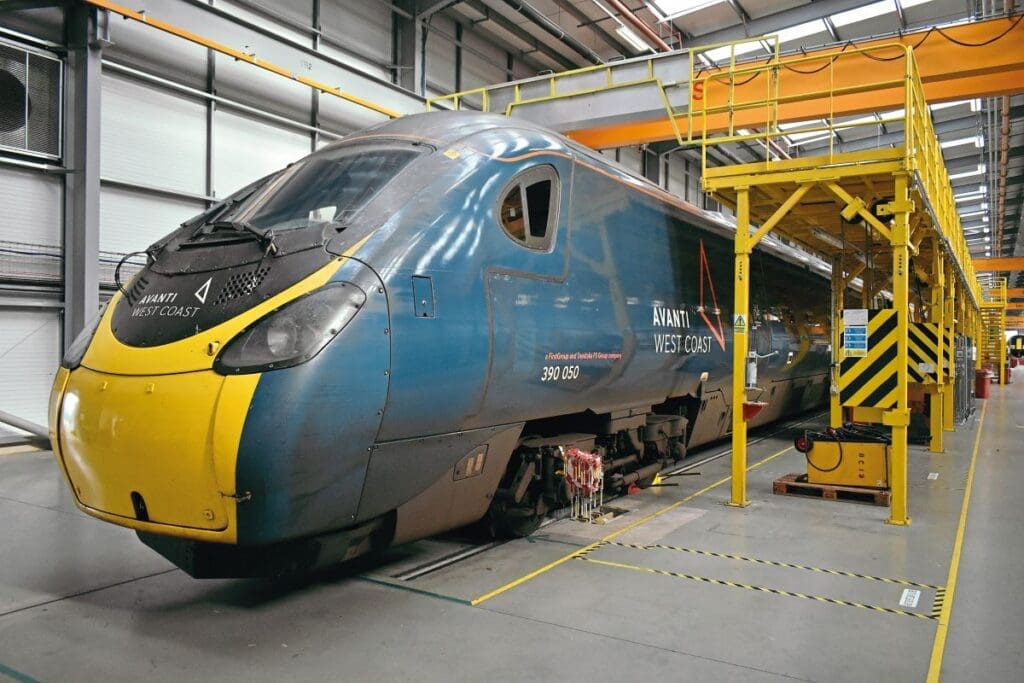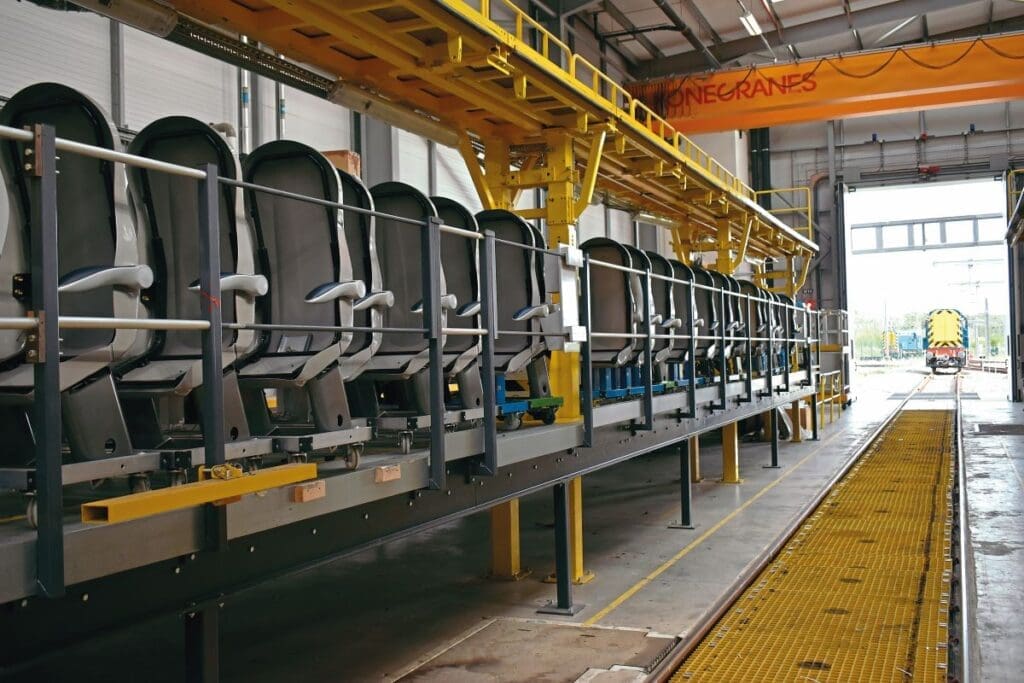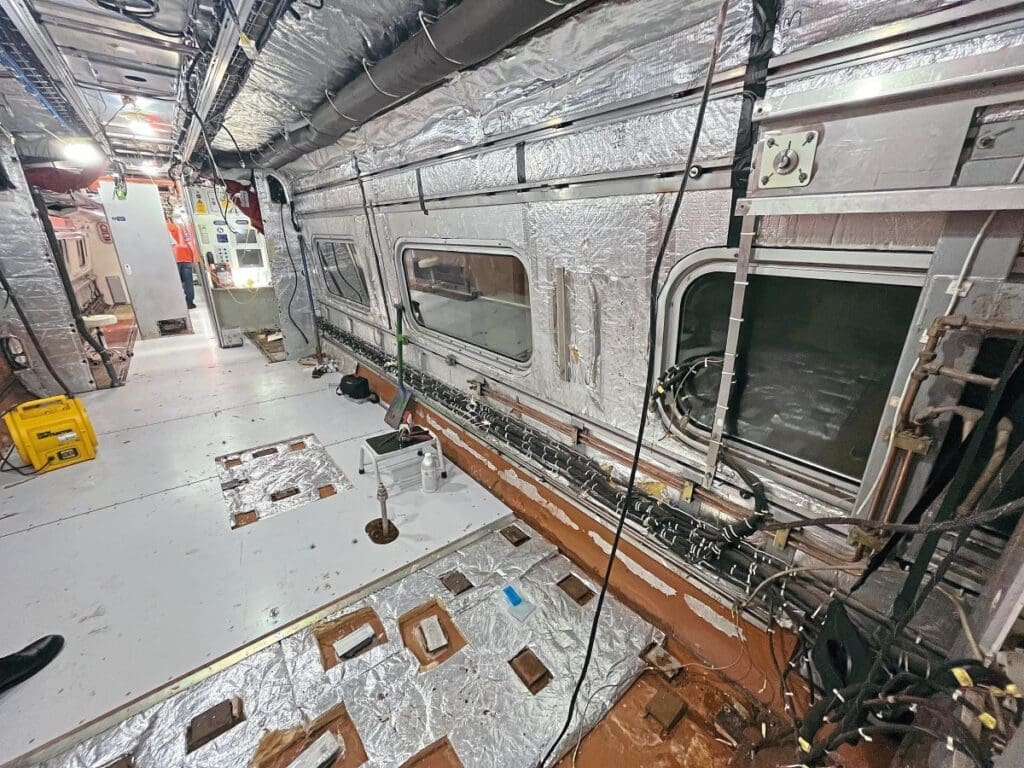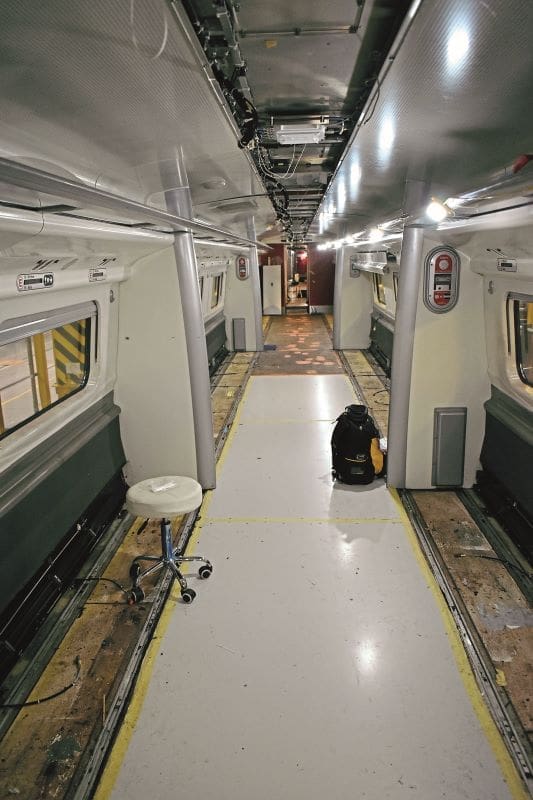Claimed to be the UK’s biggest ever fleet upgrade, the Pendolino refurbishment at Widnes has seen all the 11-car sets completed, with work now focused on the nine-car trains. Richard Clinnick reports.

More than 305 million miles have been covered by the Alstom Class 390 Pendolino fleet since they first entered traffic on the West Coast Main Line (WCML) in 2002. Indeed, in the 12 months up to September 30, 2023, the fleet had completed 14.5m miles.
Understandably that has led to the trains requiring attention and, eventually, an upgrade. A partnership approach between Alstom, which built the ‘390s’ and Angel Trains, which owns them, has created what is claimed to be the biggest ever fleet upgrade, costing some £117 million.
The fleet availability, on a Saturday-excepted service, is for 49 diagrammed sets plus one ‘hot spare’, which tallies roughly with the number in use before the pandemic. There is then one set undergoing routine maintenance at Longsight (an M exam), one undergoing a K exam and vestibule refresh at Edge Hill. This is a ‘hotel standards’ exam designed to correct cosmetic defects on both the interior and exterior). One set is undergoing an H exam at Longsight; these are undertaken every 850,000 miles with the latest round of exams starting in July, and includes the bogies, wheelsets, traction motors, brake equipment and coupling overhauls. Another set will be the ESG train at Oxley; this is the reliability train where Alstom conducts more in-depth fault-finding and special checks as required. One set can also be found at Oxley or Wembley for defect clearance (this is where extra time is needed) and the 56th set is at Widnes for its upgrade. When Rail Express visited on October 10, this was No. 390050.
Of the 11-car sets, Coach G was converted to standard class, increasing capacity across the fleet. Before that work was completed, each Class 390/1 had 444 standard class seats and 145 standard premier and first class seats, but that was changed to a total of 607 with 508 standard and 99 standard premier and first class. This enabled the diagrams mentioned previously to have 135 of the 278 services operated by 11-car trains, thus adding more than 50,000 standard class seats per week (see table below). It was for this reason that the ‘390/1s’ were treated first, says Avanti West Coast spokesperson Richard Stanton, to get the capacity benefit in place quickly.

Intensive
Sets arrive at Widnes based on several factors including where they are in their planned maintenance schedule (they will be sent to Widnes when they are unlikely to require work within that specific period) or if there is no defect clearance required for example. During the initial phases, it was vital that only 11-car sets were sent to Widnes so that AWC could get the extra standard class capacity on the WCML. This became harder towards the end of the project as fewer 11-car sets were left to be treated.
The work is intensive. Each Class 390 takes 10 days to be treated. The set arrives on the Saturday, with work beginning at 20.00 on the Sunday evening when that nightshift arrives. Straightaway the seats, tables and carpets are removed and a floorboard assessment is completed. On Day 2, the shop area is removed and floorboard replacement is complete. Day 3 involves cleaning the heater grilles and refitting them, while on Day 4 the saloon carpets are fitted. On Day 5 the toilets, vestibules and gondolas (part of the roof fittings) are completed, thus completing Week 1 for the set. OnDay 6, all new seats and luggage stacks are fitted, while on Day 7 all new tables are fitted, and the new shop is completed. Then, on Day 8, the set is moved outside, powered and various systems are started and tested. This begins two days of testing. On Day 9 both AWC and AT arrive to complete checks and accept the train back into service, and on Day 10 it departs.
The biggest issues for the project are the conversion of the No. 696xxMotor First (MF) vehicle to a Motor Standard (MS) vehicle and the replacement of floorboards across the fleet. The latter must be tested by members of staff jumping on them to test their condition – Alstom has been unable to find a more advanced method! Replacing the floorboards is an incredibly invasive process requiring the removal of parts of the saloon wall to access the boards. Initially this caused quite an issue, but the teams are now able to complete this without any concerns. For example, 54 floorboards had to be replaced on No. 390050 which is around 95% of all those fitted to the train, and yet this is not expected to have a negative impact on the time the ‘390’ is out of service.
To enable the project to be undertaken, some £3m of civils work was carried out at Widnes while 100 skilled jobs were secured by the scheme. Alstom says that 59 of the 68 suppliers are UK-based, accounting for 80% of the investment.
Up to and including October 10, Alstom said that 38 trains had been refurbished, with one returning to AWC every two weeks. That meant 412 vehicles had been treated across 35 11-car and three nine-car sets. Within those, some 18,890 new seats had been fitted as had 824 infotainment screens and 3232 new tables which have been made from recycled plastic bottles. A further 15,186 square metres of sustainable woollen carpets had also been fitted to the 38 trains so far.
The trains are being upgraded at the Widnes Transport Technical Centre facility. This opened in 2017, and it was initially planned at some stage that the site could be used to build trains, however following Alstom’s acquisition of Bombardier Transportation, that plan was shelved after Derby Litchurch Lane joined the portfolio. Instead, Widnes was placed in the parts and maintenance portfolio in 2021. A key reason for the Pendolinos being sent to the site was that it was the only one that could “swallow an 11-car train,” said Alstom head of operations and parts John Clerk.
This isn’t the first Pendolino project at the site. Repainting the sets began when it opened, with the first ‘390’ arriving in July 2017 and the final one completed in December 2019.
The site has treated more than just ‘390s’, with Mk.4s refurbished for Grand Central before the decision to abandon their use was made by the open access operator, and Class 458 reformations and refurbishment is currently underway. Indeed, on the day of RE’s visit, No. 458425 was being prepared to be hauled south to Bournemouth, while work continued on No. 458428. Other projects include various component repairs and overhauls for Jubilee and Northern Line trains and Dublin Trams.
There are three roads within the 270-metre-long shed. Within this structure there are two paint booths, overhead gantries, full roof access, and pits. One road is dedicated to the Pendolino refurbishment project, and this has had to be adapted for the shorter trains.
Indeed, planning for the shorter trains took eight months. This may sound over the top, but it had to be correct in terms of where the train was parked so that work stations and equipment could be correctly located so that the two-week beat rate of delivery was maintained. Because of the work being undertaken on different vehicles, this was vital. The nine-cars do not have the MF to MS conversion as per the 11-car sets, but they do still require other invasive work, such as the removal and subsequent refitting of the shop which has seven modules, with that work only possible when the train is in situ.

Refurbishment
Mr Clerk said that the contract was signed in 2021, with the first set arriving for refurbishment on July 18,2021. That set took 30 weeks to complete. The second set took 16 weeks; the third eight weeks and so on until Alstom got it down to a fortnight per set. “The length it took to complete the trains was helped by the downturn in the number of trains required as a result of the Covid timetable,” Mr Stanton added. So far, in 2023, all the ‘390s’ treated have been released on time.

Walking around No. 390050, Mr Clerk explains that seats are removed from the trains for refurbishment. If any are badly damaged they are disposed of, with the first class seats removed from the No. 696xx vehicles used to replace similar seats.
Some vehicles require hardly any work, for example the Driving Motor Restaurant Brake First (DMRBF)No. 691xx vehicles only having the forward-facing CCTV camera replaced and nothing done to their kitchens. Other than that, it’s the standard work as part of the refurbishment.
The former entertainment system fitted to the trains when introduced by Virgin Trains is being removed, while new charging points are being fitted to the tables, along with plug sockets and USB points. External passenger information screens are being fitted to the trains while each coach is also fitted with screens that show not only train information (calling points, estimated arrival times etc) but also CCTV from within the vehicle foradded safety. Remote conditioning monitoring is also being fitted, for example for the toilets, which will warn the fleet teams as to when they need to be emptied.
The refurbishment programme is due to be completed in June 2024, after which AWC will have a fully-upgraded fleet of ‘390s’ alongside, it is hoped, newly-introduced Hitachi Class 805s, which will have the same interiors.
It’s currently unknown how long the ‘390s’ will remain in traffic, with the original batch of 53 units (minus No. 390033 which was written off in 2007 following the Grayrigg accident) all having already covered more than 5 million miles in traffic, however the recent National Rail Contract (NRC) award for AWC made no mention of new trains within its possible nine-year length, suggesting that the trains could easily reach their 30th anniversary. If they do, they will have benefited from this major upgrade which has brought them right up to the standards of brand-new trains.
Capacity increase impact
| Route | No of 11-car sets (SX) | Net additional standard seats |
| Birmingham-Scotland | 3 | 186 |
| Euston-Birmingham-Scotland | 18 | 1116 |
| Edinburgh | 17 | 1054 |
| Glasgow Central | 30 | 1860 |
| Manchester | 49 | 3038 |
| Liverpool | 18 | 1116 |
Class 390 Mileage
| Train | Total lifetime mileage |
| 390122 | 5,792,129 |
| 390132 | 5,787,226 |
| 390136 | 5,778,197 |
| 390138 | 5,768,146 |
| 390129 | 5,764,644 |
| 390121 | 5,748,777 |
| 390119 | 5,744,744 |
| 390127 | 5,725,268 |
| 390124 | 5,724,917 |
| 390115 | 5,720,302 |
| 390020 | 5,606,679* |
| 390125 | 5,513,741** |
| 390009 | 5,329,276*** |
| 390155 | 3,378,654**** |
Note: The data is correct up to, and including, September 30, 2023.
Key: *Highest mileage nine-car set, **lowest mileage 11-car set from original order of 53 trains, ***lowest mileage nine-car set, ****lowest mileage set. No. 390033 is not included after it was written off.
Advert




